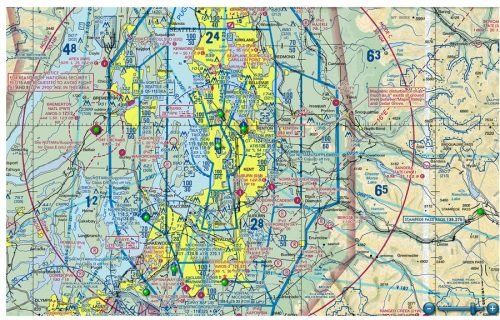 Airway space – from SkyVector aeronautical charts https://skyvector.com/
Airway space – from SkyVector aeronautical charts https://skyvector.com/
For those who moved to the Key Peninsula for the idyllic sounds of nature, the not-so-occasional sound of airplanes overhead is an unexpected jolt. Where are these planes coming from and why are they flying over the neighborhood?
Flights over cities and airports and military facilities are regulated with consideration of several factors: the safety of those on the ground, safety for incoming and outgoing flights, and national security. The Key Peninsula lies outside those highly regulated perimeters (such as Seattle, Tacoma and Olympia, the SeaTac airport, and JBLM), making it prime airspace for flight training and other overflight traffic.
According to Bonnie Malgarini, air traffic control at the Tacoma Narrows Airport, most planes in the KP airspace are private, though there are a few jets traveling between Bremerton and Olympia, typically flying at 3,000 feet. Approximately 190 aircraft are based at the airport, with nearly 79,000 takeoffs and landings each year. There are occasional medical emergency aircraft as well. Many planes fly from north to south and east to west over the Key Peninsula. She estimated that about a quarter of the air traffic is from flight schools.
The owner of a local flight school said that training includes visual flight training in the summer and instrument training, mostly in the winter. The winter instrument training, between 1,000 and 2,000 feet, is probably not visible from the ground. Students also do cross-country training, flying to airports 50 to100 miles away to include landing and takeoff practice. He said that stall training is required, but it takes place only once in a yearlong flight training course. Flight schools from Seattle, Bremerton, Gig Harbor, Shelton and Renton use the KP’s airspace.
Planes practicing repeated stalls, dives and turns are pilots practicing aerobatics and not students on training flights, he said.
All pilots must follow Federal Aviation Regulations (FAR) according to Jay Villalva, a commercial pilot who flies in the area.
FAR specifies minimum altitudes for flight. For any flight the altitude must allow an emergency landing without undue risk to people or property below if power fails. Over any congested area or where people are gathered, the altitude must be at least 1,000 feet above the highest obstacle within a horizontal radius of 2,000 feet of the plane. Over other areas, the plane must be at least 500 feet above the surface, except over open water or sparsely populated areas. In those cases, the aircraft may not be operated closer than 500 feet to any person, vessel, vehicle or structure.
Villalva estimated that a plane at 5,000 feet elevation would not be seen or heard.
Airspace is divided into categories. In the United States, those classes are A through D and G. Class A is defined by altitude—18,000 to 60,000 feet—and flights must be under air traffic control using instrument flight rules. Class B is around key air traffic areas (SeaTac Airport is one) and has the most stringent rules. Classes C and D apply to smaller airports.
Class G, according to Wikipedia, includes all airspace below 14,500 feet not otherwise classified as controlled. It is typically the airspace very near the ground (1,200 feet or less) and outside airport perimeters. Airspace over the Key Peninsula below 1,200 feet is Class G.
“Most of the general aviation traffic over the Key Peninsula is flying at 3,000 feet or less for flight training or for making approaches to the three surrounding airports (Bremerton, Tacoma and Olympia),” Villalva said. “Flying above 3,000 feet adds restrictions designed to reduce the potential for collisions, which tend to keep the local flights at or below 3,000 feet.”
UNDERWRITTEN BY THE FUND FOR NONPROFIT NEWS (NEWSMATCH) AT THE MIAMI FOUNDATION, THE ANGEL GUILD, ADVERTISERS, DONORS AND PEOPLE WHO SUPPORT INDEPENDENT, NONPROFIT LOCAL NEWS